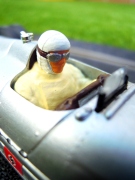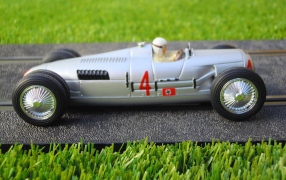


Today I’m going to continue talking a bit more extended about a car I’ve already posted: The Auto Union Type C.
Further than its unusual appearance by 1936: double rear wheels, mid-engine layout, smooth edges… there are some things you’re missing.
First of all, you can maybe image it if you take a look at the rear. Yes, you’re sight it’s ok, it counts eight exhaust pipes per side. This monster was powered by a 6 litres V16 engine and, wait for it, a pair of superchargers too. It was able to produce an impressive 510 horsepower, for a 830 kg car. This sounds even more scary if you realise there was no electronic components or driving aids. Those four rear tyres could be induce to wheelspining at speed over 150km/h. Keeping this car under control was just simply a crazy challenge.
To improve handling, this car introduced a new concept: the Limited Slip Differential, designed by Porsche previous year, which actuates as a passive traction control.
Together with mid-engine, the relative position of fuel tank in middle of both axles, just behind the driver, and allowed by engine rear layout, was a good solution to improve weight balance and not to modify weight distribuition with fuel usage.
What about the mad men who would want to drive this fatal car, Bernd Rosemeyer? When he drove by first time this beast he had no experience in racing cars, this meant a fearless man for a radically new racing car, this meant success. It only took him a few races to consolidate as a reference driver. His fame was raising and his public image improving which led him to be chosen for the Nazi Party, an ‘honour’ not ‘recommended’ to refuse, only with the condition of not wearing the SS uniform. His career continued with several victories and finally with the European Championship in 1936. It’s also known as a speedman. He repeatedly broke the speed record on public roads with a streamlined Auto Union, reaching 432km/h, which at the end would cost him his life, attemting a new record of 432,7km/h, still unbeated nowdays.






